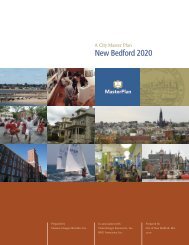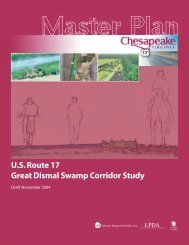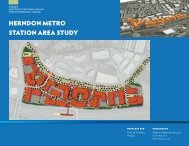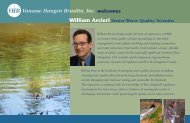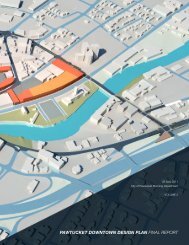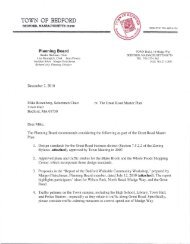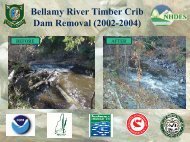Final Report - VHB.com
Final Report - VHB.com
Final Report - VHB.com
You also want an ePaper? Increase the reach of your titles
YUMPU automatically turns print PDFs into web optimized ePapers that Google loves.
5.2.3 Build Options<br />
A traffic-operations analysis, similar to the analysis of existing conditions, was<br />
conducted for the future 2035 DHVs. The analyses were conducted for each Build<br />
option considered for each Strategy.<br />
5.2.3.1 Strategy 1 – Direct Access to US Route 1<br />
Transportation Operations<br />
As described in Chapter 4, Strategy 1 considers three interchange options to improve<br />
direct access to and from US Route 1 and the NASB: Option 1 is the trumpet/loop<br />
interchange; Option 2 is the flyover interchange; and Option 3 is the split-diamond<br />
interchange.<br />
The results of the operational analyses show that each ramp movement at US Route 1<br />
(i.e., merge, diverge, and weave movements) for Options 1 and 2 operate at LOS D or<br />
better. The southbound on-ramp merge movement for both options shows an LOS D<br />
operation with all other ramp movements operating at LOS C or better.<br />
All ramp movements for Option 3 operate at LOS C or better. Additionally, the four<br />
signalized intersections located on the two connector roadways for Option 3 operate<br />
at LOS B<br />
or better. The aggressive TDM program results in modest improvement for all<br />
movements with all three options. However, for most intersections and ramp<br />
movements, the LOS is unchanged.<br />
It is important that the US Route 1 southbound off-ramp to the Coastal Connector<br />
interchange is projected to operate at LOS F by 2035. With implementation of an<br />
aggressive TDM program, the operation improves to LOS E. Nevertheless,<br />
consideration should be given – perhaps in a future planning study – to<br />
reconfiguring the interchange so that the Coastal Connector and the segment of US<br />
Route 1 north of the Connector are aligned as the highway mainline and the segment<br />
of US Route 1 southwest of the Connector being subordinate. Incidentally, this type<br />
of reconfiguration is consistent with the idea of encouraging regional through traffic<br />
to use the Coastal Connector in Topsham rather than Pleasant Street in Brunswick.<br />
The idea of directing regional through traffic to the Coastal Connector was suggested<br />
by many people throughout the public input process.<br />
All three options result in reduced traffic volume demands along Bath Road and<br />
Gurnet Road, which improves traffic operations. The intersection at Bath Road and<br />
Merrymeeting Plaza is projected to improve from LOS E under the No Action<br />
condition to LOS C for each of the three options - with and without the<br />
implementation of TDM. Similarly, the intersection at Bath Road and US Route<br />
Conclusions 147



